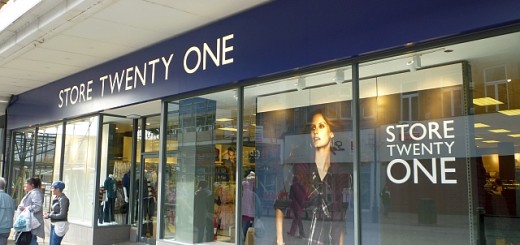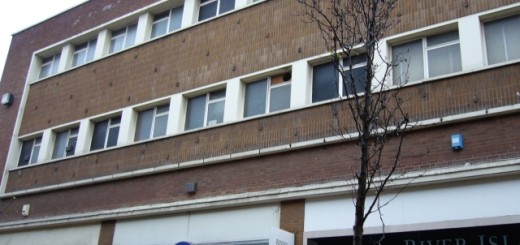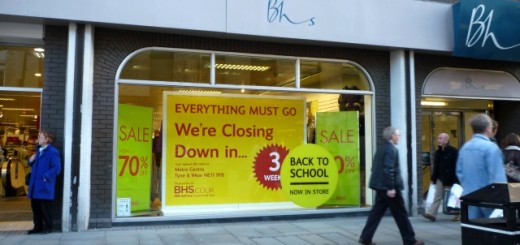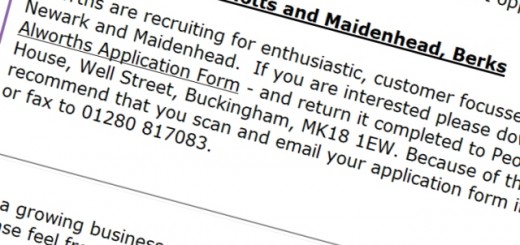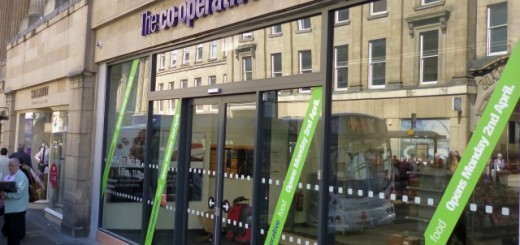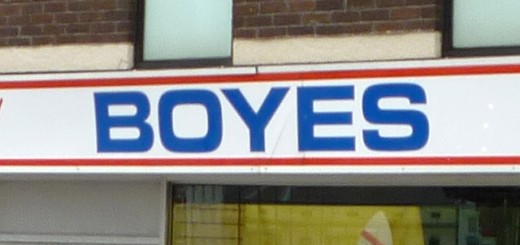One year on from the closure of BHS, what has become of the eight North East stores?
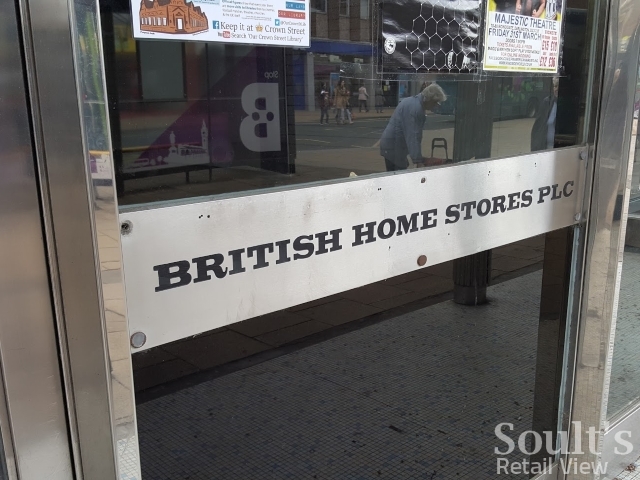
A retro touch at the ex-BHS in Darlington (12 Apr 2017)
It seems hard to believe how time has flown, but today – 28 August 2017 – represents the one-year anniversary of BHS disappearing from the British high street, 88 years after its first store opened.
As you’d imagine, BBC News has published an article to mark the occasion and assess what those vacant stores have become, while Facebook’s ‘On This Day’ handily reminded me of my appearance in The Observer a year ago, where I offered my own thoughts on what might take the ex-BHS space.
So, what has been happening over the last 12 months?
Keeping track
Whatever happens to BHS won't affect #Carlisle – store was sold before administration, and will soon become Primark pic.twitter.com/xE1ExmkkVp
— Graham Soult (@soult) June 2, 2016
Tracking what all the ex-BHS stores have become is quite a job, for several reasons (and with my limited resources I haven’t even attempted to keep entirely on top of it).
For one thing, many of the sites are requiring significant work prior to anyone new moving in – such as the removal of asbestos, and the ripping out of tired BHS interiors – meaning that there are plenty of locations that are technically empty but do have new tenants signed up and work ongoing. In some cases, too, businesses have taken only part of an ex-BHS site, or the space has been divided up amongst multiple occupants.
There’s also a bit of work involved in pinning down how many ex-BHS stores there actually are. Technically, any analysis should exclude stores that had already closed or been earmarked for closure prior to the retailer’s collapse into administration – such as Carlisle, Colchester, Fosse Park and Llanelli, all vacated to make way for Primark, as well as Southampton and Trafford Park – though these branches do still mistakenly appear on some of the administration store lists.
A BHS Lighting concession in Debenhams (in Guildford)? That's another combination I haven't seen before pic.twitter.com/JBQKmKhY33
— Graham Soult (@soult) January 25, 2016
There is also the curiosity of two BHS lighting concessions inside Debenhams, in Guildford and Oxford, which appear on some lists but not others. Again, these don’t really count, as it’s just space instore that Debenhams has presumably taken back for its own use, rather than standalone empty units.
So, excluding all these, I’ve calculated that the total number of ex-BHS stores is 164 (which is also a figure widely quoted in the press at the time).
As an aside, both Guildford (until 2010 – sold to Primark) and Oxford (until 2014 – now Topshop) were locations that had a BHS of their own until comparatively recently. Both are a reminder of how the chain had already divested tranches of the most desirable stores in the years leading up to its demise.
The UK picture
Today’s BBC News report draws from data from retail vacancy experts the Local Data Company, though, oddly, it gives the total store count as 160, rather than 164.
While the work that the LDC does undoubtedly provides some important insight into change on the UK high street, I always advise against treating its research uncritically. After all, in 2012 it was widely cited that 68 of the 807 ex-Woolworths branches had been demolished, which was clearly not right; even now, my own research indicates that the actual number of demolished Woolworths stores is just four.
Across the UK BHS estate, the LDC’s data indicates that 25 sites have been reoccupied, while a further 35 are in planning or have deals in place. Alternative research by Retail Week, in April, suggested that slightly more sites – 69 – were occupied or had deals, though it included some already-closed stores that should have been omitted (like Carlisle), and quite a few others where plans were only tentative or rumoured.
Either way, the overall picture appears to be that getting on for 100 ex-BHS stores – or 60% – remain empty one year on.
North East
Tracking the fate of the North East’s BHS stores is fairly straightforward, as there were only eight – Darlington, Durham, Hartlepool (the town’s ex-Woolworths, of course), Metrocentre, Middlesbrough, Newcastle (only opened in 2012), South Shields and Sunderland.
The LDC research for the BBC reports that 75% of these eight stores are empty, though that’s incorrect.
As I reported in October, the Hartlepool branch was fairly rapidly reoccupied by B&M, taking advantage of the fact that it was one of the most modern BHS stores, and hence pretty much ready for a new retailer to move straight into.
New city-centre @OutfitFashionUK now open in #Newcastle's ex-BHS ahead of official opening on Saturday. Nicely done inside! pic.twitter.com/7GvUIz2XOu
— Graham Soult (@soult) May 31, 2017
The same applies in Newcastle, where Arcadia’s Outfit fascia opened its first city-centre store in June. Here, as in Hartlepool, very little has been done to the exterior or interior of the existing building, beyond changing the name and products and replacing the lightbulbs – very few of which were working during the store’s dying days.
I hope when BHS is saved it can afford lightbulbs. Newcastle menswear is still like Hollister, only without hot guys pic.twitter.com/u0HN6k6ibU
— Graham Soult (@soult) May 19, 2016
The ex-BHS in Sunderland was also snapped up reasonably swiftly, with Sports Direct and USC relocating to the High Street from the Bridges shopping centre, which in turn has given River Island room to expand.
The stray BHS sign at the new Sports Direct has disappeared since I was last in #Sunderland! https://t.co/CKhvMAPLVX pic.twitter.com/Kkj83TY0Pg
— Graham Soult (@soult) May 3, 2017
So, as things stand, three of the eight ex-BHS stores in the North East have new retailers trading in them, while five – or 63% – remain vacant for now, a more promising figure than that suggested by LDC.
Work ongoing to transform ex-BHS (plus adjacent units) into a huge new Next at Metrocentre in #Gateshead pic.twitter.com/GjJcvVGCvb
— Graham Soult (@soult) May 5, 2017
However, if you include the two further sites where work is ongoing – the Metrocentre store being transformed into Next (relocating from a smaller site elsewhere in the shopping centre), and the Middlesbrough site into Flannels, Sports Direct and USC – then the picture is healthier still.
It means that the ex-BHS sites in Darlington – which I revisited last week – Durham and South Shields are the only ones in the North East that remain definitively empty.
There are some BHS sites around the UK that it’s hard to see anyone taking without significant redevelopment, though none of these three is a complete disaster. The problem, as I told The Observer a year ago, is that for sites like these, the pool of potential occupants – ones that are not already represented locally, but might wish to be – is very limited.
Darlington
Now in #Darlington, where the retro BHS fascia is still here to enjoy for now! pic.twitter.com/WndjdUO9H3
— Graham Soult (@soult) August 25, 2017
Featuring asbestos warnings in the window, and sporting the logo that BHS supposedly replaced in 1995, Darlington’s branch is definitely in the worst shape of the three. That said, the town centre, anchored by M&S and House of Fraser, is one of the North East’s most vibrant and attractive.
As I told the Northern Echo last week, the obvious candidate to fill the gap is H&M, which has recently opened branches in the much smaller retail centres of Hartlepool and Durham but is inexplicably absent from Darlington. Failing that, TJ Hughes – which has already acquired the ex-BHS in Chesterfield – would be a possibility, or perhaps a town-centre B&M (which already has an out-of-town Home Store in Darlington).
Durham
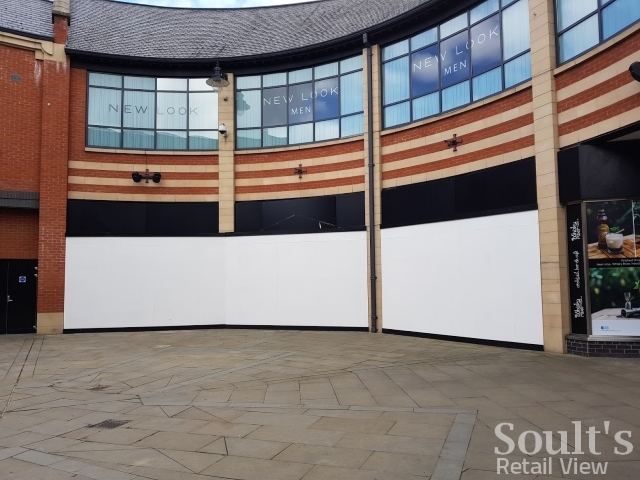
Vacant BHS in Durham (26 Apr 2017)
In contrast, Durham is a smaller retail centre, but the ex-BHS benefits from being one of the city centre’s largest, most modern and best-positioned units. Part of the problem here is that many of the plausible occupants are already at the vast (and getting bigger) out-of-town Arnison Centre.
The obvious candidate not currently represented in either location is Primark, though you suppose if it were interested it would have made a move by now. Failing that, TJ Hughes and B&M are again possibilities, or perhaps Wilko – which recently moved to the Arnison to make way for the redevelopment of its former site at The Gates – could be enticed back to the city centre.
Value chain Boyes, which has stores across County Durham, is also not yet represented in the city, though the ex-BHS site is probably more prime than it would usually go for.
South Shields
South Shields, finally, benefits from the ex-BHS being in modern and attractive premises with excellent neighbours (Debenhams, Next and River Island). The problem is that the town overall is quite weak as a retail destination, with a still-vacant Marks & Spencer and a number of other prominent voids along the main retail thoroughfare of King Street. Indeed, with a population of around 75,000, South Shields is certainly one of the smaller English town centres from which BHS was trading.
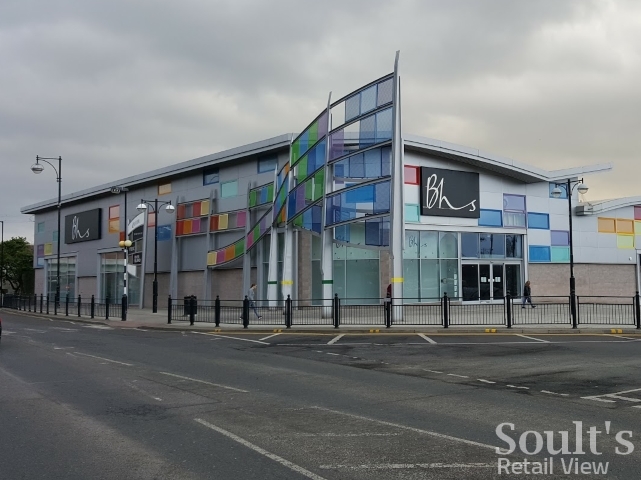
Ex-BHS in South Shields (18 Feb 2017)
The situation in the town will likely improve – the ongoing South Shields 365 regeneration programme is already having a positive impact on the town’s appearance – but at this stage it’s the quality of the Waterloo Square scheme, in which the ex-BHS sits, that is more likely to allure a big-name retailer such as TK Maxx or H&M, rather than a sense that South Shields has wider appeal as a retail centre.
Summary
Across the UK, what is notable is that really very few ex-BHS sites are being taken by the obvious candidates – Next, Primark, Wilko, and the like – because there are so few major locations left where these big names are still lacking a presence.
Instead, we’re seeing space being taken by more specialist players that still have room to grow, such as Morleys (Bexleyheath) and Flannels, and that can afford to invest a significant amount of money in turning dowdy BHS sites into exciting, modern retail interiors.
That's good timing! Paying my first visit to #Bexleyheath on the day that Morleys signage goes up at the ex-BHS. Plenty of shopper interest! pic.twitter.com/n0l7Y4NifQ
— Graham Soult (@soult) March 29, 2017
At the same time, established out-of-town retailers are using the space freed up by BHS to take surprising steps into town centres – Decathlon in Uxbridge, The Range in Redditch, or Outfit in Newcastle. Add some leisure, such as gyms and cinemas, into the mix in various locations and you have a fascinating picture of how retail centres are changing and diversifying.
A year on from the demise of BHS, there are undoubtedly still a few sites that others retailers will yet pick up – including, quite possibly, the remaining three in the North East.
However, for those sites that still remain vacant and without interest in another year’s time, more radical redevelopment to accommodate a range of uses and occupants is likely to be necessary.
Interested in working with me? Head over to CannyInsights.com to find out how I help organisations improve their market insight and digital marketing, or subscribe to Soult’s Retail Report for monthly insights into retail developments around the UK, including updates on the new occupants taking ex-BHS sites.
By supporting Soult’s Retail Report, you are also helping to sustain the informative (and free) blog updates – like this one – that so many in the retail industry find interesting, enjoyable and valuable.

